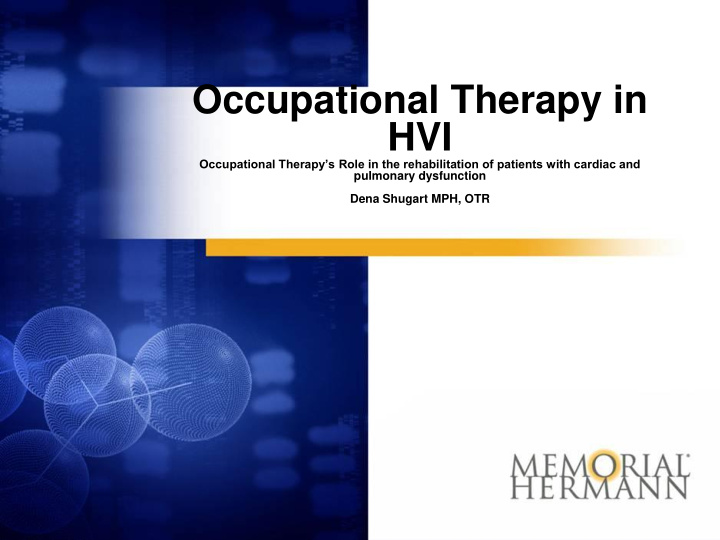



Occupational Therapy in HVI Occupational Therapy’s Role in the rehabilitation of patients with cardiac and pulmonary dysfunction Dena Shugart MPH, OTR
Evaluation • An initial evaluation will always include: – A review of the diagnosis/procedure(s) – patient’s baseline level of function (LOF) – current LOF – problem list – goals – recommendations for the next level of care
Diagnosis, Procedures/ Surgeries, LOF • In order to provide the best level of care to the patient, we strive to understand patient’s current as well as co-morbid diagnoses and any recent procedures/surgeries they have had that impact their LOF – Prior LOF • Home situation, level of independence with regards to activities of daily living • DME owned, used regularly – Current LOF • Transfers • ADLs • Upper Extremity Strength/Coordination • Cognition and current mental status • Endurance/activity tolerance/Safety
Problem List • Looking at the patient’s PLOF and CLOF, are they different? Has the patient’s level declined since admit? – Are they able to sit without support? – Transfer to a chair? – Are they participating in basic self care tasks? – Weak upper extremities? – New onset cognitive deficits? Why or why not? • What is the cause of the problem? – Poor endurance – prolonged hospital course contributing to generalized weakness – poor motivation – Pain – Family enabling patient
Occupational Therapy Goals • How can Occupational Therapy make a difference? – Education, energy conservation techniques, practice ADLs, transfers, orthotics if needed • We write goals to address patient’s deficits (examples) – Pt will be 100% compliant with sternal precautions without verbal cues/with minimal verbal cues while performing ADLs and transfers – Pt will participate in 10 minutes of ADL activity before requiring a rest break, demonstrating increased endurance – Pt will complete sink level ADLs in stance without signs or symptoms of fatigue/SOB – Pt will complete toilet transfers using rolling walker min A – Pt will complete lower body dressing seated EOB without loss of balance – Pt/pt’s family will be independent with HEP for AROM/PROM bilateral UEs
Recommendations • Consider patient’s baseline • Consider at what level are they currently performing • Consider how much family support will the patient have after discharge • Travel considerations • DME considerations
Rehab after discharge • What can the patient tolerate? – Intense post acute rehab (can tolerate 3 hours of therapy/day) – Post acute rehab (slower paced-ie SNF) – Long term acute care (LTAC) – Home with Home Health – Outpatient therapy (ie Cardiac Rehab II)
Thank you • Questions?
Recommend
More recommend